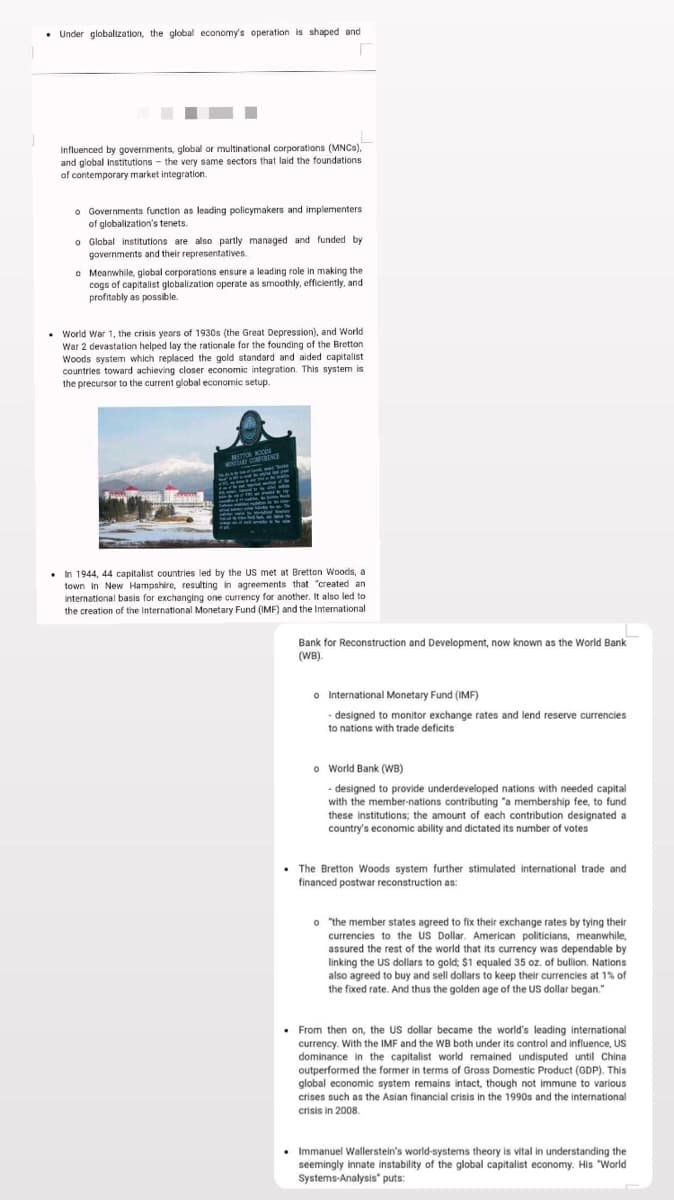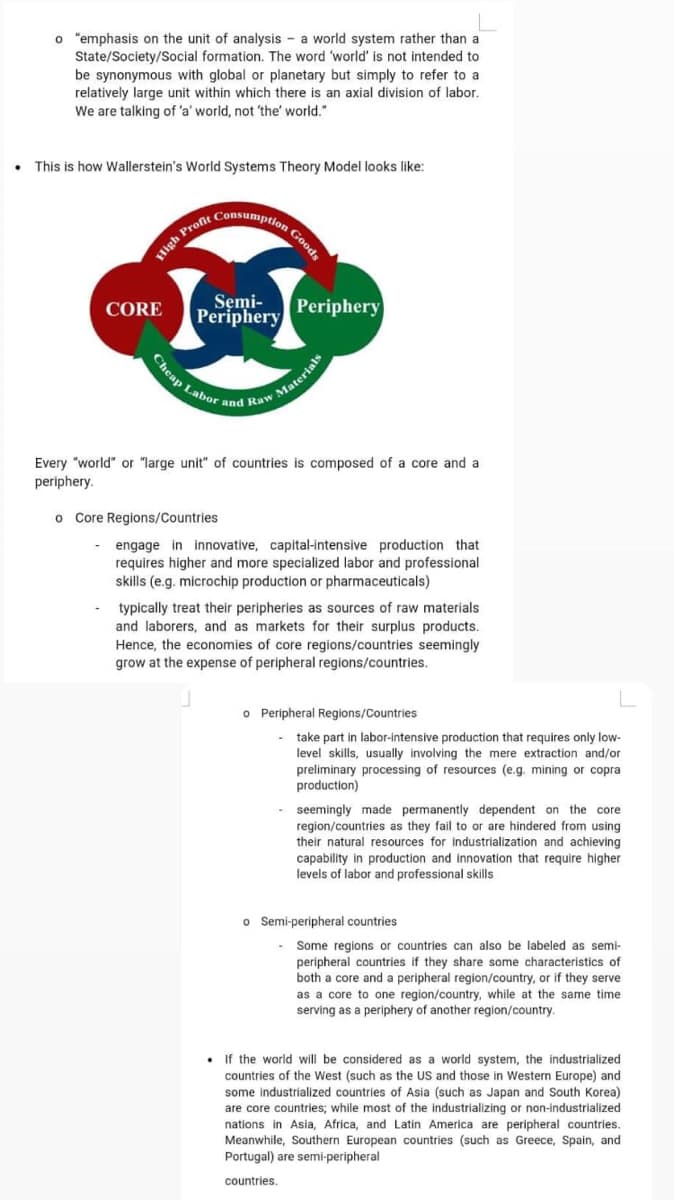Why are certain products made in the Philippines while others are produced abroad? 2. What sectors shape and influence the global economy’s operation? How do they interact with each other? 3. How did the world transition from the gold standard to the Bretton Woods system? What was its immediate impact? 4. According to Wallerstein’s world-systems analysis, to what group does the Philippines belong? Is his analysis reflective of current Philippine conditions? Explain. Photos for some reference in Question 2-4.
Why are certain products made in the Philippines while others are produced abroad? 2. What sectors shape and influence the global economy’s operation? How do they interact with each other? 3. How did the world transition from the gold standard to the Bretton Woods system? What was its immediate impact? 4. According to Wallerstein’s world-systems analysis, to what group does the Philippines belong? Is his analysis reflective of current Philippine conditions? Explain. Photos for some reference in Question 2-4.
Principles of Economics 2e
2nd Edition
ISBN:9781947172364
Author:Steven A. Greenlaw; David Shapiro
Publisher:Steven A. Greenlaw; David Shapiro
Chapter23: The International Trade And Capital Flows
Section: Chapter Questions
Problem 4SCQ: In what way does comparing a countrys exports to GDP reflect its degree of globalization?
Related questions
Question
1. Why are certain products made in the Philippines while others are produced abroad?
2. What sectors shape and influence the global economy’s operation? How do they interact with each other?
3. How did the world transition from the gold standard to the Bretton Woods system? What was its immediate impact?
4. According to Wallerstein’s world-systems analysis, to what group does the Philippines belong? Is his analysis reflective of current Philippine conditions? Explain.
Photos for some reference in Question 2-4.

Transcribed Image Text:• Under globalization, the global economy's operation is shaped and
Influenced by governments, global or multinational corporations (MNCS),
and global institutions - the very same sectors that laid the foundations
of contemporary market integration.
o Governments function as leading policymakers and implementers
of globalization's tenets.
O Global institutions are also partly managed and funded by
governments and their representatives.
o Meanwhile, global corporations ensure a leading role in making the
cogs of capitalist globalization operate as smoothly, efficiently, and
profitably as possible.
• World War 1, the crisis years of 1930s (the Great Depression), and World
War 2 devastation helped lay the rationale for the founding of the Bretton
Woods system which replaced the gold standard and aided capitalist
countries toward achieving closer economic integration. This system is
the precursor to the current global economic setup.
NETTON KOCDS
10TA ONRINCE
. n 1944, 44 capitalist countries led by the US met at Bretton Woods, a
town in New Hampshire, resulting in agreements that "created an
International basis for exchanging one currency for another. It also led to
the creation of the International Monetary Fund (IMF) and the International
Bank for Reconstruction and Development, now known as the World Bank
(WB).
o International Monetary Fund (IMF)
- designed to monitor exchange rates and lend reserve currencies
to nations with trade deficits
o World Bank (WB)
- designed to provide underdeveloped nations with needed capital
with the member-nations contributing "a membership fee, to fund
these institutions; the amount of each contribution designated a
country's economic ability and dictated its number of votes
• The Bretton Woods system further stimulated international trade and
financed postwar reconstruction as:
o the member states agreed to fix their exchange rates by tying their
currencies to the US Dollar. American politicians, meanwhile,
assured the rest of the world that its currency was dependable by
linking the US dollars to gold; $1 equaled 35 oz. of bullion. Nations
also agreed to buy and sell dollars to keep their currencies at 1% of
the fixed rate. And thus the golden age of the US dollar began."
• From then on, the US dollar became the world's leading international
currency. With the IMF and the WB both under its control and influence, US
dominance in the capitalist world remained undisputed until China
outperformed the former in terms of Gross Domestic Product (GDP). This
global economic system remains intact, though not immune to various
crises such as the Asian financial crisis in the 1990s and the international
crisis in 2008.
• Immanuel Wallerstein's world-systems theory is vital in understanding the
seemingly innate instability of the global capitalist economy. His "World
Systems-Analysis" puts:

Transcribed Image Text:Cheap Labor and Raw Materials
Consumption Goods
o "emphasis on the unit of analysis - a world system rather than a
State/Society/Social formation. The word 'world' is not intended to
be synonymous with global or planetary but simply to refer to a
relatively large unit within which there is an axial division of labor.
We are talking of 'a' world, not 'the' world."
This is how Wallerstein's World Systems Theory Model looks like:
High Proft
Semi-
Periphery
Periphery
CORE
Every "world" or "large unit" of countries is composed of a core and a
periphery.
o Core Regions/Countries
- engage in innovative, capital-intensive production that
requires higher and more specialized labor and professional
skills (e.g. microchip production or pharmaceuticals)
typically treat their peripheries as sources of raw materials
and laborers, and as markets for their surplus products.
Hence, the economies of core regions/countries seemingly
grow at the expense of peripheral regions/countries.
o Peripheral Regions/Countries
take part
level skills, usually involving the mere extraction and/or
labor-intensive production that requires only low-
preliminary processing of resources (e.g. mining or copra
production)
seemingly made permanently dependent on the core
region/countries as they fail
their natural resources for industrialization and achieving
capability in production and innovation that require higher
levels of labor and profe
o or are hindered from using
onal skills
o Semi-peripheral countries
Some regions or countries can also be labeled as semi-
peripheral countries if they share some characteristics of
core and a peripheral region/country, or if they serve
as a core to one region/country, while at the same time
serving as a periphery of another region/country.
both
• If the world will be considered as a world system, the industrialized
countries of the West (such as the US and those in Western Europe) and
some industrialized countries of Asia (such as Japan and South Korea)
are core countries; while most of the industrializing or non-industrialized
nations in Asia, Africa, and Latin America are peripheral countries.
Meanwhile, Southern European countries (such as Greece, Spain, and
Portugal) are semi-peripheral
countries.
Expert Solution
This question has been solved!
Explore an expertly crafted, step-by-step solution for a thorough understanding of key concepts.
This is a popular solution!
Trending now
This is a popular solution!
Step by step
Solved in 3 steps

Knowledge Booster
Learn more about
Need a deep-dive on the concept behind this application? Look no further. Learn more about this topic, economics and related others by exploring similar questions and additional content below.Recommended textbooks for you

Principles of Economics 2e
Economics
ISBN:
9781947172364
Author:
Steven A. Greenlaw; David Shapiro
Publisher:
OpenStax

Principles of Economics 2e
Economics
ISBN:
9781947172364
Author:
Steven A. Greenlaw; David Shapiro
Publisher:
OpenStax